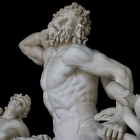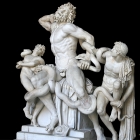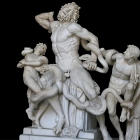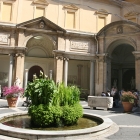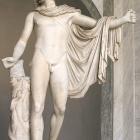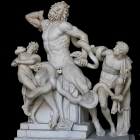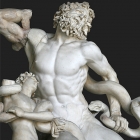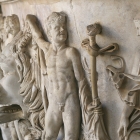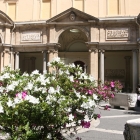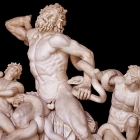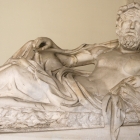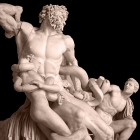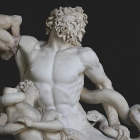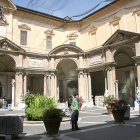The statue of the priest Laocoon in Vatican Museum
Though he appears only briefly in the Iliad, the Trojan priest Laocoon comes to represent the voice of reason. He is the one that warns the Trojans of the wooden horse trick that would lead to the destruction of the city. The Trojan war is the most important and most complex myth of ancient Greek world. Retold by Homer and probably other bards, this epic battle, that was probably inspired by an actual event, makes humans interact with gods, thus presenting the main myths associated with each of them.
The story starts in Olympus among deities. Uninvited to a party, Eris takes a very clever revenge by throwing inside a golden apple with the inscription “to the fairest”. Immediately, Hera/Juno (the wife of Zeus), Athena/Minerva (goddess of war and wisdom) and Aphrodite/Venus (goddess of beauty) begin to quarrel, so Zeus sends them to a mortal to settle their dispute. Paris, the arbiter, is promised fame and wisdom but choses the gift of Aphrodite’s, which was to have the most beautiful woman in the world. But Helen was married to a Greek king, so Paris kidnapped or reduced her and took her to Troy.
The allied armies of the Greeks (Achaeans) sieged the city for years, but with little success. Finally, Odysseus/Ulysses comes out with a brilliant plan. They built a giant wooden horse in which a band of soldiers hide, while the rest of the army embark and pretend to sail away home. Laocoon is the only one who is suspicious of the gift left by the Greeks on the shore, uttering the famous words “I fear Greeks even when they bring gifts”.
Afraid that the plan of her protégé, Ulysses, might fail, Athena blinded Laocoon. But the Trojans took this as a sign that their priest was committing a sacrilege urging to burn the wooden horse. So they broke the gates of the city and brought in the Trojan horse, from which the soldiers came out during the night after the party. So Troy was sacked and destroyed.
Laocoon died killed by serpents sent by Athena, together with his two sons, Antiphantes and Thymbraeus.
The fabulous marble sculpture depicting the death of Laocoon is attributed to three sculptors: Agesander, Athenodoros and Polydorus. This masterpiece of ancient art was studied and taken as a model by the greatest sculptors or Renaissance who were impressed by the perfect reproduction of human anatomy and emotions as well as by the dynamic that the block of marble seems to have.
The statuary group of Laocoon and his sons can be seen in the Vatican Museum in Rome, in a small but beautiful interior garden alongside other antiquities. The two interior courtyards that visitors pass in their regular tours used to be only one, the Belvedere courtyard, but were separated by the construction of another wing of the palace. Pope Julius II brought the statue of Laocoon here after its discover in 1506.
Mai multe despre: Greece, Italia • Agesander • Antiphantes • art • Athenodoros • Italia • Italy • Laocoon • Polydorus • Rome • sculpture • Thymbraeus • Trojan • Vatican • Vatican Museum- Home Page
start page - Architecture
landmark buildings - Sacred architecture
places of worship - Nature
landscape photography - Concert
performing artists - Christmas
Santa Claus pictures
- Jooble
jobs for photographers - Escape
an out of control blog - Merry Christmas
The best organizer of Christmas parties - Astro photo
Eclipse hunting and astrological photography

